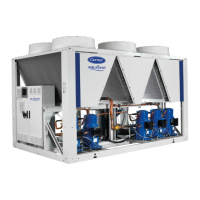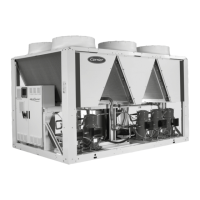6
Do not clean the unit with hot water or steam. This could
pressurise the refrigerant.
NOTE:
If a liquid line valve is present, never leave refrigerant in liquid
form between this closed valve and the expansion valve as the
change in temperature may cause the liquid to expand,
rupturing this section of the circuit. This valve is situated on
the liquid line before the lter drier.
Never apply an open flame or pressurised steam to a
refrigerant container. Dangerous overpressure can result. If it
is necessary to heat the refrigerant, only use hot water.
The standard NF E29-795 describes the regulations permitting
conditioning and recovery of halogenated hydrocarbons under
optimum quality conditions for the products and optimum
safety conditions for people, property and the environment.
If any damage is caused to the equipment, the refrigerant must
be changed in accordance with this standard, or any analysis
of the uid must be performed by a specialist laboratory.
Any refrigerant transfer and recovery operations must be
carried out using a transfer unit.
Service valves are positioned on the liquid, suction and
discharge lines and are available on all units for connection
to the transfer unit.
The units must never be modied to add refrigerant and oil
charging, removal and purging devices. These units have the
required openings. Refer to the certied dimensional drawings.
It is dangerous and illegal to re-use disposable (non-
returnable) cylinders or attempt to rell them. When the
cylinders are empty, evacuate the remaining gas pressure, ll
out the relevant paperwork and hand them over to an
approved recovery agency. Do not incinerate.
Operating checks:
IMPORTANT:
This product contains uorinated greenhouse gas covered by
the Kyoto protocol.
Type of uid: refer to the nameplate
Global Warming Potential (GWP): refer to the table below
► All interventions on this product's refrigerating circuit
must be performed in accordance with applicable
legislation. Within the European Union, this legislation
notably includes regulation No. 517/2014, known as
F-Gas.
► Ensure that refrigerant is never released to the
atmosphere when the equipment is installed,
maintained or sent for disposal.
► It is prohibited to deliberately release refrigerant into
the atmosphere.
► If a refrigerant leak is detected, ensure that the leak is
repaired quickly.
► Only certied, qualied personnel are permitted
to install
, service and perform sealing tests on the
refrigerant, decommission the equipment and recover
the refrigerant.
► The operator must ensure that any refrigerant
recovered is recycled, regenerated or destroyed.
► The operator is bound by the obligation to perform
sealing tests, or have these performed, at regular
intervals.
Regulations within the European Union have set the following
intervals:
detection
No test 12 months 6 months 3 months
No test 24 months 12 months 6 months
2
)
< 5
tonnes
5 ≤ charge
< 50
tonnes
50 ≤
charge <
500 tons
Charge >
500
tonnes
(1)
R134a
(GWP 1430)
Charge <
3.5 kg
3.5 ≤
charge <
34.9 kg
34.9 ≤
charge <
349.7 kg
Charge >
349.7 kg
R407C
(GWP 1774)
Charge <
2.8 kg
2.8 ≤
charge <
28.2 kg
28.2 ≤
charge <
281.9 kg
Charge >
281.9 kg
R410A
(GWP 2088)
Charge <
2.4 kg
2.4 ≤
charge <
23.9 kg
23.9 ≤
charge <
239.5 kg
Charge >
239.5 kg
HFOs:
R1234ze
No requirement
(1) From 01/01/2017, units must be equipped with a leak detection system.
► For all equipment subject to regular sealing
tests, the operator must keep a log used to record
the following: the quantities and types of uids
contained in the system (added and recovered), the
quantity of uid recycled, regenerated or destroyed,
the date and results of the sealing tests, the details of
the technician and of the company performing the
work, etc.
► Contact your local dealer or installer if you have
any questions.
Information on operating inspections given in EN 378 standard
can be used when similar criteria do not exist in the national
regulation.
Check regularly for leaks and repair immediately.

